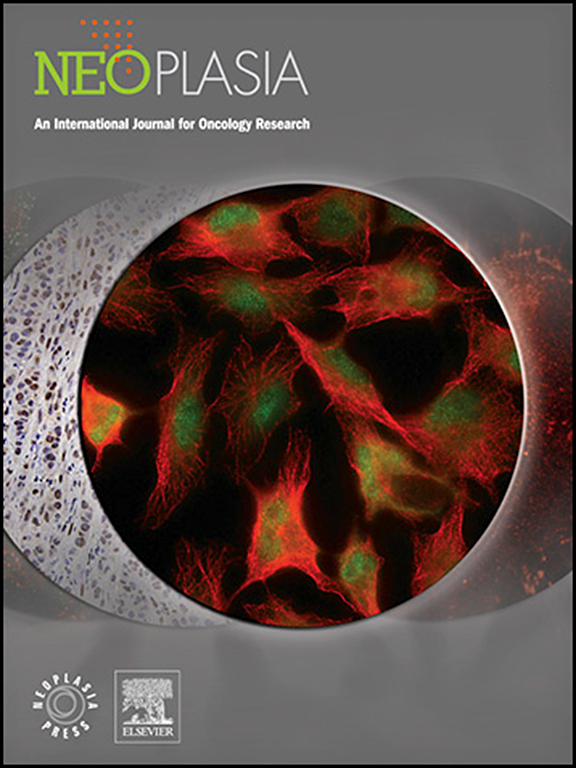Transcriptomic and proteomic profiling identifies feline fibrosarcoma as clinically amenable model for aggressive sarcoma subtypes
IF 7.7
2区 医学
Q1 Biochemistry, Genetics and Molecular Biology
引用次数: 0
Abstract
Fibrosarcomas (FSA) are malignant mesenchymal tumors characterized by low chemo- and radiosensitivity. Development of novel treatment strategies for human adult FSA is hindered by the low incidence and the absence of suitable clinical models. Interestingly, aggressive FSA occur more frequently in domestic cats, hence potentially representing a clinically amenable model to assess novel therapies such as targeted imaging or theranostics. However, a lack of molecular characterization of FSA and adjacent normal tissue (NT) in both species hinders identification of tumor-specific targets and undermines the translational potential of feline FSA. Combining laser-capture microdissection, RNAsequencing and liquid chromatography-tandem mass spectrometry, we perform comprehensive profiling of 30 feline FSA and matched skeletal muscle, adipose and connective tissue. Clear inter-tissue differences allow identification of significantly upregulated and tumor-exclusive features that represent potential targets for diagnostic and therapeutic approaches. While feline FSA are characterized by hyperactive EIF2, TP53 and MYC signaling, immune-related and neuronal pathways emerge as modulators of tumor aggressiveness and immunosuppression. A high degree of molecular similarity with canine and adult FSA allows identification of tumor targets that are conserved across species. Significant enrichment in DNA repair pathways in feline FSA correlate with aggressive clinical behavior in human soft-tissue sarcoma. Finally, we leverage the molecular profiles to identify vulnerabilities, including sensitivity to ATR and PARP inhibition as potential treatment for feline FSA. In conclusion, this detailed landscape provides a rich resource to identify target candidates and therapeutic vulnerabilities within and across species and supports feline FSA as relevant models for the human disease.
转录组学和蛋白质组学分析确定猫纤维肉瘤是侵袭性肉瘤亚型的临床适用模型。
纤维肉瘤(FSA)是一种恶性间质肿瘤,其特点是化疗和放射敏感性低。人类成人FSA的新治疗策略的发展受到低发病率和缺乏合适的临床模型的阻碍。有趣的是,侵袭性FSA在家猫中发生的频率更高,因此可能代表了一种临床适用的模型来评估新的治疗方法,如靶向成像或治疗。然而,缺乏这两个物种中FSA和邻近正常组织(NT)的分子特征阻碍了对肿瘤特异性靶点的识别,并破坏了猫FSA的转化潜力。结合激光捕获显微解剖,rnas测序和液相色谱-串联质谱,我们对30只猫的FSA和匹配的骨骼肌,脂肪和结缔组织进行了全面的分析。明确的组织间差异允许识别显著上调和肿瘤特异性特征,这些特征代表了诊断和治疗方法的潜在目标。虽然猫的FSA以过度活跃的EIF2、TP53和MYC信号为特征,但免疫相关通路和神经元通路是肿瘤侵袭性和免疫抑制的调节剂。犬类和成人FSA的高度分子相似性允许鉴定跨物种保守的肿瘤靶点。猫FSA中DNA修复通路的显著富集与人类软组织肉瘤的侵袭性临床行为相关。最后,我们利用分子谱来确定脆弱性,包括对ATR和PARP抑制的敏感性,作为猫FSA的潜在治疗方法。总之,这种详细的景观提供了丰富的资源来确定候选靶点和物种内部和跨物种的治疗脆弱性,并支持猫FSA作为人类疾病的相关模型。
本文章由计算机程序翻译,如有差异,请以英文原文为准。
求助全文
约1分钟内获得全文
求助全文
来源期刊

Neoplasia
医学-肿瘤学
CiteScore
9.20
自引率
2.10%
发文量
82
审稿时长
26 days
期刊介绍:
Neoplasia publishes the results of novel investigations in all areas of oncology research. The title Neoplasia was chosen to convey the journal’s breadth, which encompasses the traditional disciplines of cancer research as well as emerging fields and interdisciplinary investigations. Neoplasia is interested in studies describing new molecular and genetic findings relating to the neoplastic phenotype and in laboratory and clinical studies demonstrating creative applications of advances in the basic sciences to risk assessment, prognostic indications, detection, diagnosis, and treatment. In addition to regular Research Reports, Neoplasia also publishes Reviews and Meeting Reports. Neoplasia is committed to ensuring a thorough, fair, and rapid review and publication schedule to further its mission of serving both the scientific and clinical communities by disseminating important data and ideas in cancer research.
 求助内容:
求助内容: 应助结果提醒方式:
应助结果提醒方式:


